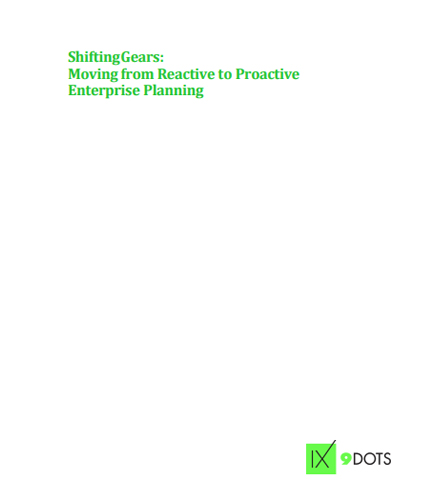
PROCESSING. PLEASE WAIT...


White Paper: 9Dots Management Corp, LLC
The proactive planning and analysis components of a comprehensive, enterprise planning system enables any organization to quickly deliver a sophisticated, linked planning model that accurately reflects business in all its inevitable complexity and detail.Is your organization able to employ the best practices for proactive planning, budgeting, forecasting and analytics?
This whitepaper comprehensively describes the process changes that enterprise planning and analysis approach enable:
Whole company involvement: Unify and automate planning process
Data integration and integrity better planning and high-demand forecasting
Shortened Cycle Time with Proactive Planning and Forecasting
Rapid modeling for easy adoption of enterprise planning solution
Download this insightful white paper to learn how to make the most effective decision for your organization. It addresses questions like:
What are the key elements of a highly-effective planning and forecasting process for enterprises seeking higher levels of performance and business optimization?
Why are companies moving to rolling forecasts in lieu of an annual budget cycle?
How are leading organizations meeting today’s challenges through proactive planning and analysis?
How to improve cost discipline and mitigate risk with a proactive planning solution?
By: HSO
The commitment of an integrated ERP (Enterprise Resource Planning) solution can inspire any business owner to approve a costly, time-consuming planning and execution process. However, not all ERP implementations are successful; many end in frustration, failure and wasted resources. To prevent a disaster with your ERP implementation, arm yourself with the right resources to avoid such failure. This whitepaper highlights the 10 common ERP implementation mistakes made by organizations and advises on how to overcome the challenges and complexities of ERP deployment. Some of the most commonly cited ERP implementation mistakes and their fixes appear below: Be realistic in your ERP project planning Compliance issues relevant to your business while choosing an ERP solution Roll out pilot programmes for each ongoing phase of an ERP implementation Choose the right ERP vendor Thus it will help your company make the right decision on choosing your ERP software provider and business software solutions partner, and what to expect from them.
By: Circadence
Cyber‐attacks and threats against the financial services sector are ongoing – common targets include banks, payment processing companies, investment firms, and other organizations that manage financial transactions. A 2016 study reported that 83% of financial services companies cite defending against cyber threats and protecting personal data as one of their biggest challenges in building or maintaining their reputation over the next year. Gamification has the potential to bring a financial company's cyber security posture to the next level, producing both value and competitive advantage. Gamification allows companies to best determine how they direct their resources toward mitigating vulnerabilities and threats. Key takeaways from this white paper: Overview: Cyber‐attacks and threats against the financial services sector Gamifying Cybersecurity: An opportunity for financial services companies Project Ares: Solution to the Cybersecurity training gap ‐ a gamified training platform Preserveing cyber team’s footprint: For future analysis, tracking of growth, and to facilitate strategic role assignments


 2025 All Rights Reserved | by: www.ciowhitepapersreview.com
2025 All Rights Reserved | by: www.ciowhitepapersreview.com